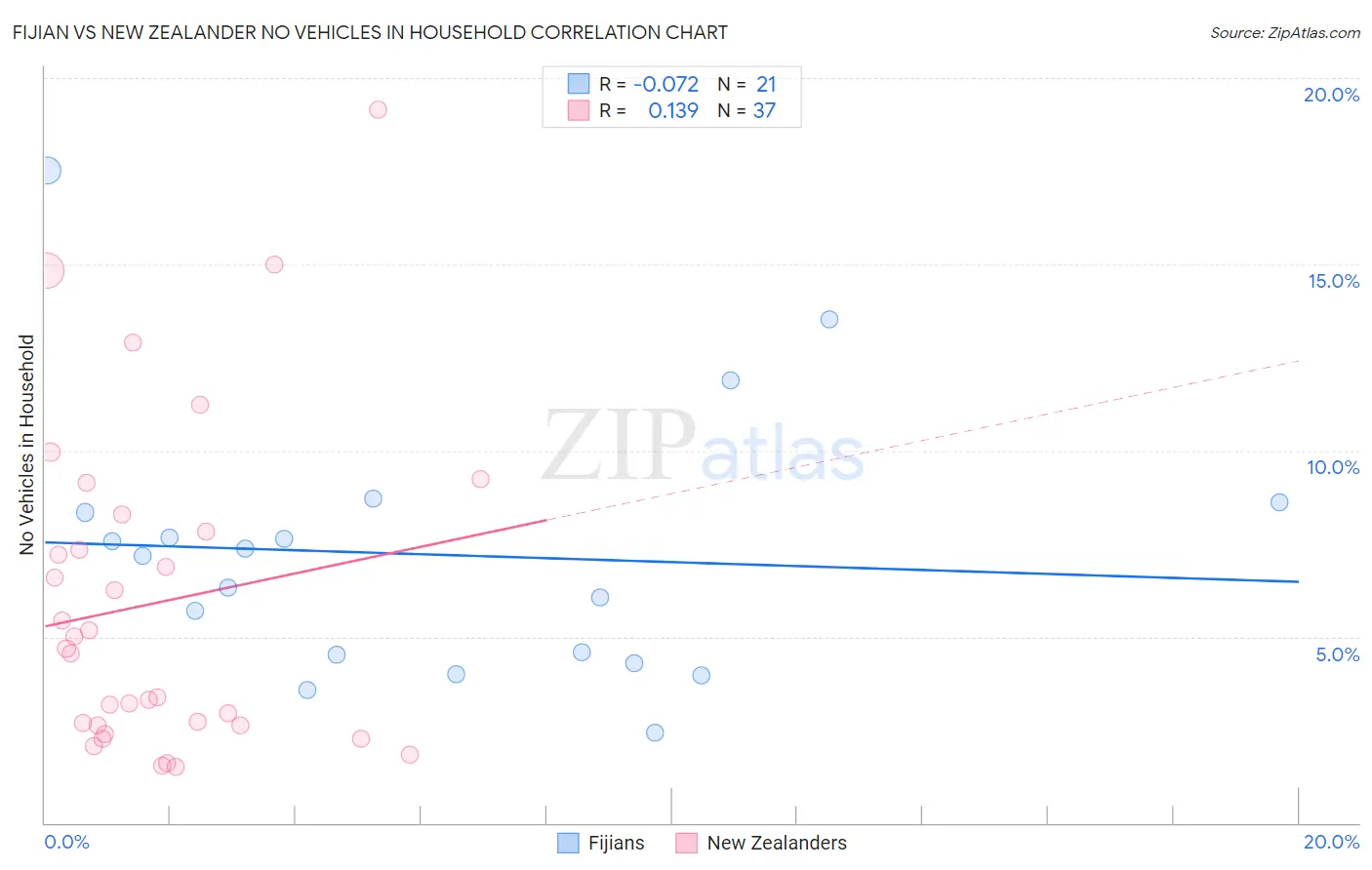Fijian vs New Zealander No Vehicles in Household
COMPARE
Fijian
New Zealander
No Vehicles in Household
No Vehicles in Household Comparison
Fijians
New Zealanders
9.5%
NO VEHICLES IN HOUSEHOLD
92.7/ 100
METRIC RATING
119th/ 347
METRIC RANK
10.2%
NO VEHICLES IN HOUSEHOLD
65.1/ 100
METRIC RATING
161st/ 347
METRIC RANK
Fijian vs New Zealander No Vehicles in Household Correlation Chart
The statistical analysis conducted on geographies consisting of 55,930,698 people shows a slight negative correlation between the proportion of Fijians and percentage of households with no vehicle available in the United States with a correlation coefficient (R) of -0.072 and weighted average of 9.5%. Similarly, the statistical analysis conducted on geographies consisting of 106,783,580 people shows a poor positive correlation between the proportion of New Zealanders and percentage of households with no vehicle available in the United States with a correlation coefficient (R) of 0.139 and weighted average of 10.2%, a difference of 7.1%.

No Vehicles in Household Correlation Summary
| Measurement | Fijian | New Zealander |
| Minimum | 2.4% | 1.5% |
| Maximum | 17.5% | 19.1% |
| Range | 15.1% | 17.7% |
| Mean | 7.2% | 5.9% |
| Median | 7.2% | 4.7% |
| Interquartile 25% (IQ1) | 4.4% | 2.6% |
| Interquartile 75% (IQ3) | 8.5% | 8.1% |
| Interquartile Range (IQR) | 4.1% | 5.4% |
| Standard Deviation (Sample) | 3.6% | 4.3% |
| Standard Deviation (Population) | 3.5% | 4.3% |
Similar Demographics by No Vehicles in Household
Demographics Similar to Fijians by No Vehicles in Household
In terms of no vehicles in household, the demographic groups most similar to Fijians are Immigrants from Thailand (9.5%, a difference of 0.060%), Greek (9.5%, a difference of 0.11%), Puget Sound Salish (9.5%, a difference of 0.16%), Costa Rican (9.5%, a difference of 0.21%), and Chippewa (9.4%, a difference of 0.66%).
| Demographics | Rating | Rank | No Vehicles in Household |
| Armenians | 95.0 /100 | #112 | Exceptional 9.4% |
| Immigrants | Netherlands | 94.8 /100 | #113 | Exceptional 9.4% |
| Serbians | 94.3 /100 | #114 | Exceptional 9.4% |
| Navajo | 94.2 /100 | #115 | Exceptional 9.4% |
| Japanese | 94.1 /100 | #116 | Exceptional 9.4% |
| Chippewa | 93.8 /100 | #117 | Exceptional 9.4% |
| Greeks | 92.9 /100 | #118 | Exceptional 9.5% |
| Fijians | 92.7 /100 | #119 | Exceptional 9.5% |
| Immigrants | Thailand | 92.6 /100 | #120 | Exceptional 9.5% |
| Puget Sound Salish | 92.4 /100 | #121 | Exceptional 9.5% |
| Costa Ricans | 92.3 /100 | #122 | Exceptional 9.5% |
| Blackfeet | 91.4 /100 | #123 | Exceptional 9.6% |
| Immigrants | Korea | 90.9 /100 | #124 | Exceptional 9.6% |
| Immigrants | Cameroon | 90.6 /100 | #125 | Exceptional 9.6% |
| Icelanders | 90.2 /100 | #126 | Exceptional 9.6% |
Demographics Similar to New Zealanders by No Vehicles in Household
In terms of no vehicles in household, the demographic groups most similar to New Zealanders are Immigrants from Middle Africa (10.2%, a difference of 0.10%), Immigrants from Austria (10.2%, a difference of 0.10%), Immigrants from Cambodia (10.2%, a difference of 0.21%), South African (10.2%, a difference of 0.58%), and Comanche (10.2%, a difference of 0.63%).
| Demographics | Rating | Rank | No Vehicles in Household |
| Sioux | 72.4 /100 | #154 | Good 10.1% |
| Salvadorans | 72.4 /100 | #155 | Good 10.1% |
| Immigrants | Micronesia | 70.9 /100 | #156 | Good 10.1% |
| Australians | 70.6 /100 | #157 | Good 10.1% |
| Spanish American Indians | 70.2 /100 | #158 | Good 10.1% |
| Immigrants | Indonesia | 69.3 /100 | #159 | Good 10.1% |
| Immigrants | Middle Africa | 65.7 /100 | #160 | Good 10.2% |
| New Zealanders | 65.1 /100 | #161 | Good 10.2% |
| Immigrants | Austria | 64.4 /100 | #162 | Good 10.2% |
| Immigrants | Cambodia | 63.7 /100 | #163 | Good 10.2% |
| South Africans | 61.1 /100 | #164 | Good 10.2% |
| Comanche | 60.8 /100 | #165 | Good 10.2% |
| Immigrants | Costa Rica | 60.5 /100 | #166 | Good 10.3% |
| Immigrants | Saudi Arabia | 58.8 /100 | #167 | Average 10.3% |
| Indonesians | 56.7 /100 | #168 | Average 10.3% |